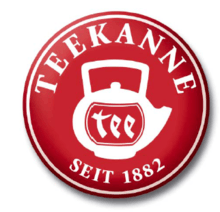Teekanne (company)
 | |
| Founded | 16. July 1882, Dresden |
|---|---|
| Headquarters | Düsseldorf, Germany |
Number of employees | 1500 |
| Website |
www |
Teekanne GmbH & CO. kg is a German tea trading company, based in Düsseldorf. The founders Rudolf Anders and Eugen Nissle were the first to sell tea in tins and already mixed teas on a high quality level. Furthermore, they went on to invent the machine-made tea bag.[1] Today the family-run company is still the world leading company in the production of tea bags and produces 7.5 million tea bags per year.[2]
History
Teekanne, then known under the name “R.Seelig & Hille”, was found on 16 July 1882 Dresden.[3] In 1888 the company was renamed “Theekanne”, old German spelling for "Teekanne" (meaning: teapot), and registered as a trademark. The registration number 6541 makes it one of Germany´s oldest trademarks still existing.[4] The two employees Eugen Nissle and Rudolf Anders bought the company in 1892; the first to sell blended, packaged tea. The company has remained family-owned ever since.
In 1912 the tea brand “Teefix” was registered, along with the "Pompadour" brand.
During World War I , Teekanne provides soldiers and civilian with so called “tea bombs”, a sweet portion of tea in small gauze bags. These handmade bags are the precursor to the modern tea bag [5][6]
In 1929 the first tea bag packing machine worldwide is launched, designed by Adolf Rambold, an employee of the company. The “Pompadour” machine can produce 35 gauze bags in one minute.
In 1931 the next generation, Ernst Rudolf Anders and Johannes Nissle, take over the family business. Anders takes part in the trip of the LZ 129 Hindenburg in the US 1937 and dies during the Hindenburg explosion in Lakehurst , United States .
During the last days of World War II Dresden and Teekanne take heavy damage. In 1946 the restoration of the company begins in modest surroundings in Viersen , Germany, on the Lower Rhine.
In 1948 a company for the production of tea bags is founded, called “Teepack”. Adolf Rambold becomes co-owner [7] and unveils his fully automatic tea bag machine, the "Constanta", in 1949. It produces up to 160 double chamber tea bags a minute. The revolutionary double chamber tea bag is protected by patent.
The company moves his head offices to Düsseldorf in 1957.
The further development of the “Constanta” is launched: the “Perfecta”. She produces 400 double chamber bags in a minute and is sold worldwide.
Teekanne Austria was found in Salzburg with their own production in 1951. In 1996 it takes over the sugar substitute brand "Kandisin" in Vienna, the market leader in the Austria.
In 1991 Teekanne returns to its roots and acquires Teehaus GmbH (formerly VEB Kaffee und Tee), in Radebeul near Dresden. This brings Teekanne back to Dresden, its original location.
2006 the German tennis legend Steffi Graf becomes the new face and brand ambassador of Teekanne.
Sixty years after the production was placed in Düsseldorf-Heerdt, Teekanne opened a new production hall. Due to the high efficiency it has been the latest production hall in Europe in 2014.[8]
Subsidaries
The following companies belong to the Teekanne Group:
- Teepack Spezialmaschinen GmbH & Co. KG, Düsseldorf, Germany (1948)
- Teekanne Ges.m.b.H, Salzburg, Austria (1951)
- Pompadour Te srl GmbH, Bolzano, Italy (1964)
- Pompadour Iberica S.A, Alicante, Spain (1985)
- Teehaus GmbH, Radebeul/ Dresden, Germany (1991)
- Teekanne Polska, Krakow, Poland (1992)
- Teekanne Cesca, Prague, Czech Republic (1994)
- Redco Foods Inc., Windsor, Connecticut, USA (1995)
- Junket
- Red Rose Tea (United States)
- Salada (United States)
References
- ↑ Stadführer Dresen, Wissenswetes über Dresen (Tourguide Dresdenm things to know about Dresen, retrieved 07-26-2016
- ↑ Lars Mueller: Dresden und Meissner Land, Sächsische Zeitung 16th of July 2007, page 15, Dresdner Druck- und Verlagshaus GmbH & Co KG. Dresden
- ↑ H. Morgenbesser: Die Teewirtschaft, Deutsche Großbetriebe Band 2, page 48, Hans Christoph Reisner Verlag, Berlin 1957
- ↑ H. Morgenbesser: Die Teewirtschaft, Deutsche Großbetriebe Band 2, page 50, Hans Christoph Reisner Verlag, Berlin 1957
- ↑ Stadführer Dresen, Wissenswetes über Dresen (Tourguide Dresdenm things to know about Dresen, retrieved 07-26-2016
- ↑ Der Tee und seine Experten, page 36, Teekanne GmbH, Düsseldorf 1982
- ↑ H. Morgenbesser: Die Teewirtschaft, Deutsche Großbetriebe Band 2, page 52-53, Hans Christoph Reisner Verlag, Berlin 1957
- ↑ Jeschenko Media agency, retrieved 2016-07-22.